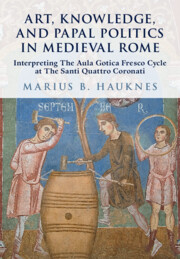 Art, Knowledge, and Papal Politics in Medieval Rome
Art, Knowledge, and Papal Politics in Medieval Rome Published online by Cambridge University Press: 30 January 2025
The preceding chapters have argued that the Anagni and Santi Quattro Coronati frescoes are products of the significant cultural and intellectual expansion that occurred in Rome and the papal state during the middle decades of the thirteenth century. In their own distinct ways, the two monuments brought together worldly and religious knowledge within stylistically uniform and spatially immersive pictorial programs. As assemblages of varied forms of learning, the two mural cycles invited reflective viewing, and in many cases required viewers to make interpretive connections between spatially distant images. Such dynamic interaction between educated viewers and architecturally embedded images could generate combinatory and associative interpretations that granted individual motifs new levels of meaning based on their relation to other images within the cycle. In this way, each monument functioned not only as a monumental image of the world’s knowledge but also as an interactive tool for philosophical thinking.
To save this book to your Kindle, first ensure [email protected] is added to your Approved Personal Document E-mail List under your Personal Document Settings on the Manage Your Content and Devices page of your Amazon account. Then enter the ‘name’ part of your Kindle email address below. Find out more about saving to your Kindle.
Note you can select to save to either the @free.kindle.com or @kindle.com variations. ‘@free.kindle.com’ emails are free but can only be saved to your device when it is connected to wi-fi. ‘@kindle.com’ emails can be delivered even when you are not connected to wi-fi, but note that service fees apply.
Find out more about the Kindle Personal Document Service.
To save content items to your account, please confirm that you agree to abide by our usage policies. If this is the first time you use this feature, you will be asked to authorise Cambridge Core to connect with your account. Find out more about saving content to Dropbox.
To save content items to your account, please confirm that you agree to abide by our usage policies. If this is the first time you use this feature, you will be asked to authorise Cambridge Core to connect with your account. Find out more about saving content to Google Drive.